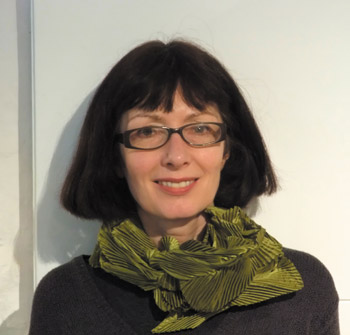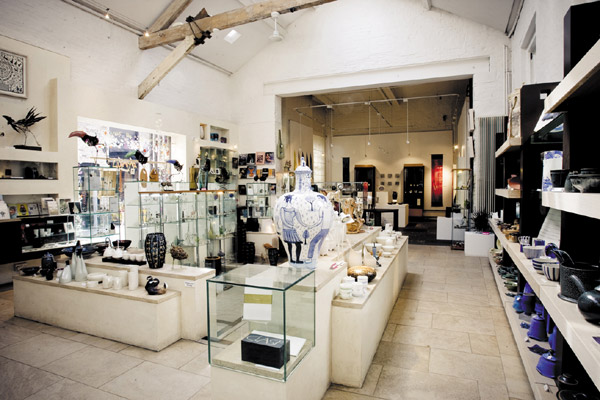
| HOME |
| NERVE |
| REVIEWS |
| ARCHIVE |
| EVENTS |
| LINKS |
| ABOUT US |
| CONTRIBUTORS |
| BACK ISSUES |
| CONTACT US |
Back to index of Nerve 24 - Summer 2014
College Lane, in the centre of Liverpool, is home to an esoteric and utterly wonderful art space. It has ended up, accidentally, within the perimeters of the Liverpool One complex. Its fortunes have changed over the years but it has managed to not only survive but thrive, thanks to the efforts, taste and sheer determination of one woman, Maureen Bampton, its director since 1986, and the supportive and talented team she has built up since.
The Bluecoat Display Centre - a unique space in Liverpool
 An
interview with director Maureen Bampton by Gayna
Rose Madder
An
interview with director Maureen Bampton by Gayna
Rose Madder
The Bluecoat Display Centre (BDC) was founded by Professor Gardner-Medwin in 1959. Having had an artist's studio himself in the building, he had struggled to find examples for sale of decorative arts, locally. He formed a charitable board which, perhaps inspired by the Contemporary Arts Centre, looked to establishing a space where crafts would become more design-led in philosophy and execution.
Maureen Bampton had worked at The Bluecoat and its café on placement as a student, while completing a BA at Hope University. Although loving the building and its history, her interest in 19th/ 20th century decorative arts also led to internships at Liverpool Museum. When her course finished, and with the previous incumbent having been in place for 28 years, Maureen had not been expecting to be offered the job as director of BDC.
A huge renovation in the 1990s saw architect Maggie Pickles, who had her own Bluecoat studio, look to introducing a light and airy feel while retaining the warmth and character beloved of the space. Dropping the level of the windows and using multiple layers of glass shelving throughout, she is working with Liverpool designers 'Definitive' to create an environment where the work displayed can evolve and reflect current thinking and practice. There are always new artists and artisans graduating, and a more diverse snapshot of what is currently happening can be presented, although, because the centre also has to function as a commercially viable shop, a decision was made to show a greater percentage of jewellery, ceramics and glass.
And hereby hangs a tale. In 2011 BDC lost all of its regular funding from the Arts Council (as did many other local arts organisations). It had never received local financing, eg from Liverpool City Council, despite many applcations. The only way forward in terms of retaining its independent and cutting-edge status was for the centre to apply for grants for individual or outreach projects. There have also been schemes involving local artists working with visitors and social groups, and running related workshops. One set of pilot schemes for one year's funding was successful, but at the time of writing there is no news of a second year.
This has placed a far bigger emphasis on fundraising involving the entire staff team. The property is rented and there are no large reserves of capital. As a purely trading organisation, this has meant that educational and outreach organisations have had to fundraise events themselves.
 |
2008 was a difficult year. A relocation to Hanover St while the original Bluecoat building underwent significant renovations, over-ran and meant the original space was not ready in time for Liverpool's year as 'Capital of Culture'. But this was not the only reason for this to be a year to remember for all the wrong reasons.
Maureen had met her husband Tony through the local scene in 1970. Fellow jumble-sale goers and with similar interests in music, they would celebrate vintage finds in a climate where most of the other customers were often 40 years older. He specialised in books, she in fashion. Having moved to Cornwall in 1972, after their son Joe was born in January 1973, the family returned to Wirral. Missing the Southern markets, they discovered that Peter Halligan, a friend of Tony's, had set up a vintage re-selling business known as 'Aunt Twackys' in Mathew St. They set up their own successful business, before the start of Maureen’s tenure at the Display Centre.
But in 2007 Tony was diagnosed with cancer, and despite an operation, died in September 2008. Losing a lifelong partner so suddenly is almost unimaginable. Yet this was not the last tragedy to befall Maureen.
Last year saw the double loss of her son Joe, and his girlfriend Zsi, in a freak air balloon accident in Egypt. Both were successful practising artists, he having studied at Slade and she at Kingston. All the bedrocks and security most can expect to support them throughout life had disappeared within a few short years.
Yet for the astonishingly strong Maureen, she has chosen to see this as having to start a new life.
Her stability now has become her job. Friends and family living close helped her to survive such horrors as the media camping out on her doorstep when the terrible accident occurred.
Among the positives she has achieved since is sponsoring the People's Prize, (part of the Liverpool Art Prize Awards). She is working closely with businesses and encouraging their support, and working closely in partnerships with arts and social care organisations. She has, for understandable reasons, had to pull out of some high-profile invitations, eg one at the Saatchi Gallery last year.
Despite difficulties which would have floored most people, both personally and professionally, this remarkable woman has managed to make this space continue to work, along with her team.
Despite the cutbacks and financial constraints, the Centre has managed not to move away from what some would deem its somewhat risky strategy of continuing to support cutting edge processes and emerging artists, where there are no guarantees in terms of income or outcome. In particular, local artists often find an early home to exhibit innovative art and sometimes to work at the centre. It is a unique and wonderful place led by an amazingly visionary woman. It should be cherished and appreciated, as should she.